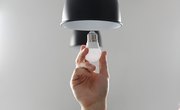The electromagnetic spectrum spans radio waves, with wavelengths of a millimeter or more, to gamma rays, with wavelengths less than a trillionth of a meter. Ultraviolet light has wavelengths from about 1 to 400 nanometers (nm), where a nanometer is 10-9 meters. Visible light, or more simply light, is electromagnetic radiation in the range of approximately 400 to 750 nm, while infrared light has wavelengths from about 750 to 2500 nm.
Radiant and Luminous Flux of a Light Source
Like all electromagnetic radiation, light is a form of energy. Radiant flux, or power, is the total energy per second emitted from a source. Radiant flux is expressed in watts (W) and results from the output at all wavelengths.
Unlike radiant flux, the luminous flux of a source is the output power in only visible wavelengths, which excludes ultraviolet and infrared radiation. In SI units, luminous flux is expressed as lumens (lm) and is determined by weighting the output power to account for the human eye’s sensitivity to various wavelengths.
For example, a 100-W incandescent bulb consumes 100 watts of electrical power to produce only 10 watts of visible light. The remaining power becomes 90 watts of infrared light and waste heat, which are visually useless. The radiant flux includes infrared light and would be close to 100 watts. The luminous flux, however, would be only the 10 watts of power in visible wavelengths, weighted to reflect our eyes' response, to yield about 1,600 lumens.
Relationship Between Luminous Flux and Lux
Luminous flux measures how we perceive the brightness of a light source. Many situations, however, require knowing the amount of light shining on an object. To have a safe warehouse space with good visibility, a property manager must determine floor-level illumination with a light meter. Illuminance is the amount of luminous flux per unit area and is expressed as lux (lx) in SI units. One lux is one lumen per square meter and therefore measures the human perception of the brightness of light at a given point.
How Light Diminishes With Distance
For a source that shines equally in radial directions, the amount of light on a unit area decreases by the inverse-square law. If a certain light bulb shines on a spot 1 meter away, the illuminance there might be 900 lux. A spot 2 meters away would be at double the distance and therefore would have only 1/22, or one-quarter the illuminance, which would be 225 lux. A spot 3 meters away would be at triple the distance and would have only 1/33, or one-ninth the amount of light, only 100 lux.
If the light originates from a source that is not a point, such as from a tubular fluorescent bulb, or if the light is manipulated by lenses, mirrors or reflectors, then the inverse-square law may not apply.
Lux Measurement Procedure
The human eye has maximum sensitivity to light in the band of green-yellow wavelengths, from about 520 to 580 nm. This sensitivity falls to less than 15 percent of the maximum for red at one end of the spectrum and 10 percent for blue at the other end. Most lux meters use a single silicon sensor with optical filters to imitate this sensitivity profile to various degrees.
Lux meter measurements are generally accurate with incandescent lights because the spectral output is very similar for all incandescent sources. However, the many types of LEDs and fluorescent lights (high-intensity discharge, metal halide, high-pressure sodium and cool white office lights), each have different spectral profiles. High-quality lux meters closely reproduce the eye’s visual response and can accurately measure these other light sources, too.
Lux meters that poorly follow the eye’s sensitivity curve require a color correction factor (CCF) that adjusts the lux meter measurement for LEDs or fluorescent lights. Therefore, you need to know the type of light you are measuring and use the appropriate CCF.
The lux measurement procedure simply requires positioning a meter’s sensor on the surface or location where you wish to measure the incident light. The sensor should face the light source at a right angle. If the sensor is not perpendicular to the light, the measurement will be incorrect, though some lux meters have a cosine correction to account for the angle. Meters that require a color correction factor may have a means of inputting the CCF to adjust the result for LEDs or fluorescent lights; otherwise, you will have to manually multiply the measured lux by the CCF.
References
Resources
About the Author
H. L. M. Lee is a writer, electronics engineer and owner of a small high-tech company. He also produces web content and marketing materials, and has taught physics for students taking the Medical College Admissions Test. In addition, he has written numerous scripts for engineering and physics videos for JoVE, the Journal of Visualized Experiments. H.L.M Lee earned his undergraduate engineering degree at UCLA and has two graduate degrees from the Massachusetts Institute of Technology. More information about him and his work may be found on his web site at https://www.hlmlee.com/
